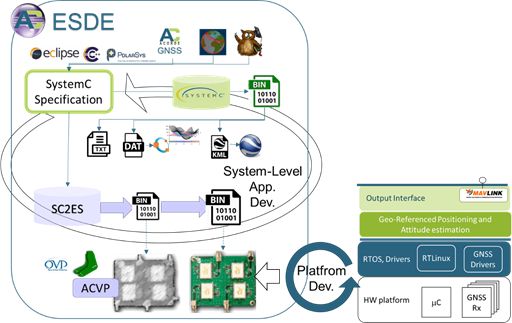WP6-ESDE: Difference between revisions
(Created page with "=ESL embedded Software Design Environment (ESDE)= {|class="wikitable" | ID|| WP6-ESDE |- | Contributor || ACORDE |- | Levels || Tool, Platform |- | Require || Linux, Virtual Platform Development Platform |- | Provide || Executable System-Level modelling, automated embedded software generation, Virtual Platform based validation |- | Input || SystemC models, RTOS API target, Platform target, Platform model |- | Output || Functional and time performance validat...") |
|||
| Line 19: | Line 19: | ||
| TRL || 4 | | TRL || 4 | ||
|} | |} | ||
The design approach, yet used for some GLAD+ development and explained in [[WP5-15_2]] has proven to be useful and enables model building/refinement relying on raw sensor data logged at past captures. | |||
However, it has also some important disadvantages. One of them is associated to the conventional, sequential HW/SW development. HW platform design and implementation comes before driver development or RTOS port (if required). In turn, HW/SW platform availability is a pre-condition for application development. Once the application is ready, it is possible to evaluate if the performance (timing, memory, energy and power consumption, etc) and validate it. As well as the long latencies involved, the flow adds the risk of late finding of performance bottlenecks that involve a drastic re-design, of hardware in the worst case. To these drawbacks, we need to add the high cost of translation of Matlab models to C/C++ implementation, and the traceability problems generated at the validation time. | |||
== Detailed Description == | == Detailed Description == | ||
In COMP4DRONES, ACORDE is developing and evaluating a newer approach to overcome those drawbacks. It is sketched in Figure 69. The ESDE framework developed in WP6 [33], is encrusted in at a top level layer, for a system-level approach to embedded software design and development, to encompass the conventional HW/SW platform development capabilities and processes of ACORDE. | |||
[[File:wp3-15_2_05.png|frame|center| System-level methodology for the design and implementation of outdoor geo-referenced position&attitude estimation systems in COMP4DRONES]] | |||
==Contribution and Improvements== | |||
Some key aspects of the ESDE flow for productivity improvement are: | |||
* The fast functional models that can be built at the top lever, able to significantly speed-up functional validation vs Matlab model execution. | |||
* The automated embedded software generation mechanisms that avoid a significant translation effort from the system model to the implementation C/C++ code. | |||
* The possibility to parallelize of the development of firmware (binary or object file), or very close version of it with HW development, by relying on a high-fidelity virtual platform. | |||
* The possibility to validate firmware (without availability of the physical platform), eventually using several virtual platforms for test parallelization | |||
== Interoperability with other C4D tools == | == Interoperability with other C4D tools == | ||
| Line 29: | Line 43: | ||
==Current Status== | ==Current Status== | ||
==Design and Implementation== | ==Design and Implementation== | ||
Revision as of 08:22, 25 March 2022
ESL embedded Software Design Environment (ESDE)
| ID | WP6-ESDE |
| Contributor | ACORDE |
| Levels | Tool, Platform |
| Require | Linux, Virtual Platform Development Platform |
| Provide | Executable System-Level modelling, automated embedded software generation, Virtual Platform based validation |
| Input | SystemC models, RTOS API target, Platform target, Platform model |
| Output | Functional and time performance validation. Close to production firmware generation and validation. |
| C4D tooling | n.a. |
| TRL | 4 |
The design approach, yet used for some GLAD+ development and explained in WP5-15_2 has proven to be useful and enables model building/refinement relying on raw sensor data logged at past captures. However, it has also some important disadvantages. One of them is associated to the conventional, sequential HW/SW development. HW platform design and implementation comes before driver development or RTOS port (if required). In turn, HW/SW platform availability is a pre-condition for application development. Once the application is ready, it is possible to evaluate if the performance (timing, memory, energy and power consumption, etc) and validate it. As well as the long latencies involved, the flow adds the risk of late finding of performance bottlenecks that involve a drastic re-design, of hardware in the worst case. To these drawbacks, we need to add the high cost of translation of Matlab models to C/C++ implementation, and the traceability problems generated at the validation time.
Detailed Description
In COMP4DRONES, ACORDE is developing and evaluating a newer approach to overcome those drawbacks. It is sketched in Figure 69. The ESDE framework developed in WP6 [33], is encrusted in at a top level layer, for a system-level approach to embedded software design and development, to encompass the conventional HW/SW platform development capabilities and processes of ACORDE.
Contribution and Improvements
Some key aspects of the ESDE flow for productivity improvement are:
- The fast functional models that can be built at the top lever, able to significantly speed-up functional validation vs Matlab model execution.
- The automated embedded software generation mechanisms that avoid a significant translation effort from the system model to the implementation C/C++ code.
- The possibility to parallelize of the development of firmware (binary or object file), or very close version of it with HW development, by relying on a high-fidelity virtual platform.
- The possibility to validate firmware (without availability of the physical platform), eventually using several virtual platforms for test parallelization
Interoperability with other C4D tools
TBC
